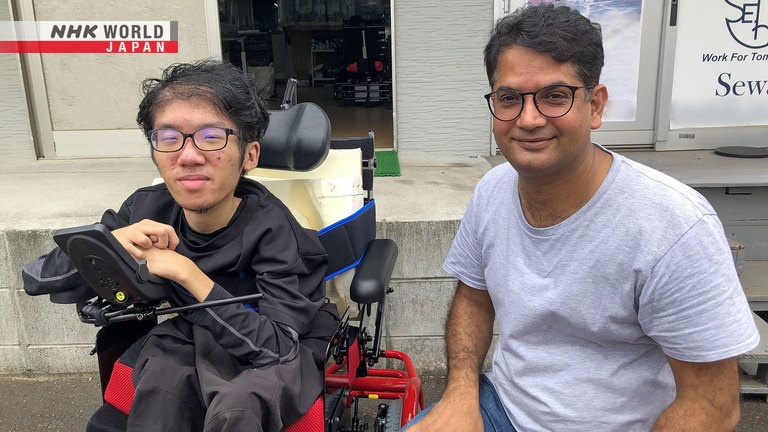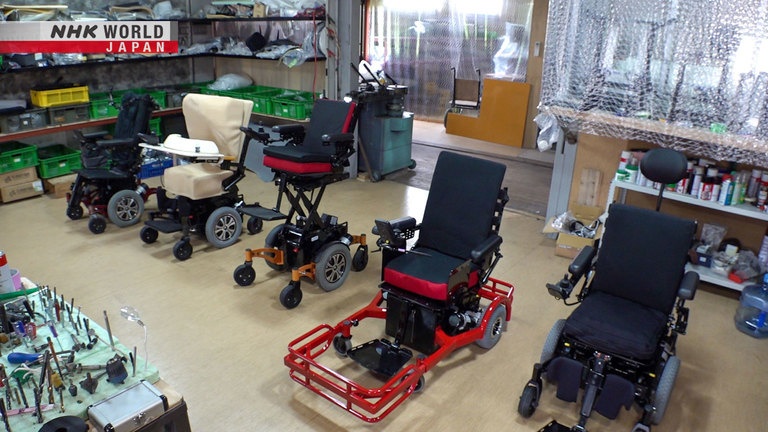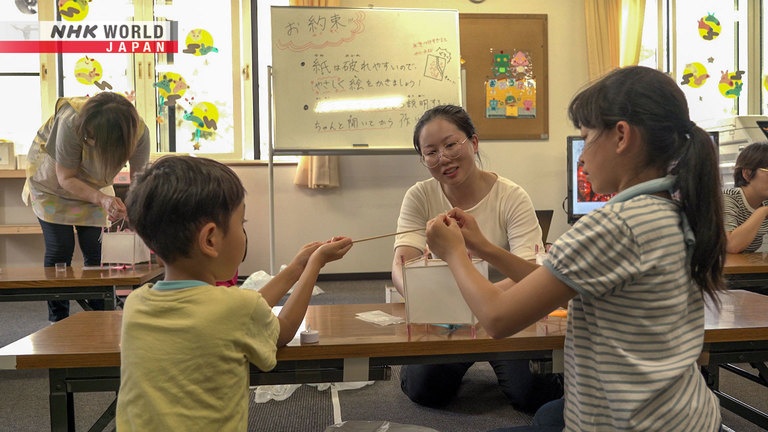A Crafter of Life-changing Wheelchairs
On this episode, we visit the workshop of Habib ur Rahman, a craftsman from Pakistan who designs and builds power wheelchairs in Kobayashi City, Miyazaki Prefecture. Believing that a wheelchair can change one's life, he custom-makes all his creations to fit each user's needs. We follow Habib as he designs a new wheelchair for a teenager suffering from a muscular disease. We also meet Chinese-born Xia Siya, who works for a children's education support program set up by Yubari City in Hokkaido Prefecture.




Transcript
Where We Call Home.
Powerchair football, a sport for para-athletes with higher levels of physical disabilities.
Assisting this teenage boy is a custom wheelchair designer from Pakistan, Habib ur Rahman.
Custom-fitted chairs offer users many
possibilities, yet require little strength.
Habib has been in this line of work for over twenty years.
He listens to what each user wants and makes repeated adjustments to create a chair that's tailor-made to their needs.
A wheelchair can change
the life of its user.
Each chair is adapted to its user's size and level of disability.
How do you do?
Pouring his heart and soul into his work...
...Habib is driven by his wish to bring hope and smiles to those with disabilities.
Kobayashi City in Miyazaki Prefecture.
Spring water from the Kirishima Mountains are a source of life and prosperity for the town's inhabitants.
This is where Habib's workshop is located.
- Good morning!
- Hi!
- So many wheelchairs.
- I'm currently working on 1, 2, 3, 4.
Habib designs, welds, paints and assembles power wheelchairs, order-made for each user.
In recent years, he puts particular effort into making them lighter.
For example, he's cut the weight of a two-hundred-kilo chair down to half.
His creations can turn around in a one-meter-wide space for greater mobility.
With optional features such as adjustable elevation and the ability to recline,
some chairs can reach prices way beyond the ten-thousand-US-dollar mark.
Many users rely on financial support from local government to purchase their wheelchair.
Habib's creations count many a proud owner.
Today, he meets a client for whom he's been adjusting her chair for over a year.
She asked for a new modification.
This is a first for me.
The armrests are directed inward.
This user needed the armrests to point inward.
Through trial and error, Habib fine-tuned their position.
Hi!
It's finally ready.
How does it look?
- They're quite inward.
- Yes.
I've turned them quite inward.
One, two...
Komaki Megumi suffers from a condition that causes her muscles to weaken and atrophy.
She asked Habib to design and build her first made-to-order wheelchair.
- How is it?
- The right could be more inward.
Megumi's request for the armrests' position is because, until now,
when one of her arms slipped off, putting it back up by herself was an arduous task.
Here we go.
Yes, this is just right.
The chairs require repeated adjustments to adapt them to the users' changing needs.
In that way, Habib is like a lifelong partner for each user.
- Thank you.
- It's great.
It looks much better.
It's very comfortable.
It took a year, but it worked.
Thank you.
Hi!
- How are you?
- I'm good.
Habib is the eighth born in a family of ten siblings.
His older brother Shafiq who lives in their native Pakistan, has a disability.
The two regularly speak through video chat.
I got my chair fixed.
Shafiq is behind the reason why Habib found his calling as a wheelchair maker.
Shafiq once came to Japan to study how to help people with disabilities be more socially active,
and returned to Pakistan with a used wheelchair.
Back then, because wheelchairs in Pakistan were mainly used for people with severe conditions,
Habib's family was surprised.
People thought he was hurt.
He told them not to worry.
He said the chair made him free.
I was impressed.
'What an amazing chair!'
Shafiq asked his brother to use his natural talent for tinkering to make him a wheelchair.
However...
I took it apart...
so I could see the parts I needed.
Then my brother slapped me.
'Why did you do that!?'
Habib began to teach himself how to build a wheelchair.
Then came a major turning point.
The Kashmir earthquake of 2005.
More than 70,000 people lost their lives, and many more were injured.
We had to build wheelchairs.
I didn't know the basics.
So, I came to Japan and visited makers
to learn how to build wheelchairs.
Habib trained to learn the craft in Tokyo.
He took the knowhow he acquired back to Pakistan where he helped build some 13,000 manual wheelchairs.
Habib later met a Japanese woman, got married, and thus returned to Japan once again.
That's when he learned about power wheelchairs.
He was amazed to see how they enabled people with severe disabilities to move around freely.
Habib's vision is to create wheelchairs that enrich people's lives.
For this, he wants to talk with each one of his clients to design and build the chair
that will best help them achieve their dreams.
Iwakiri Fumiyo uses her lips to operate her wheelchair.
She's afflicted with an illness that causes her muscles to weaken.
I can recline using my mouth.
I can do it myself.
So, I don't feel any discomfort.
I can recline and rest anytime.
Rather than asking someone
to move me around...
I can, for example, adjust
my distance from this image.
To be able to this by myself freely
makes such a difference.
Habib wants to support as many people with disabilities as possible in becoming more active members of society.
For over ten years,
he's been contributing to a project that collects wheelchairs in Japan that are no longer in use,
and sends them overseas.
A wheelchair can change
the life of its user.
It helps make life more enjoyable.
The Kajiki Special Needs School is for children and teens with chronic illnesses and physical disabilities.
One of the students here asked Habib to make him a new power wheelchair.
I came to see your school.
A third-year high-schooler, Idosaki Ryuto commutes from the hospital to this school.
Soon after birth, Ryuto lacked muscular strength,
and though he could stand on his own until third grade, he later needed to use a wheelchair.
Once he began using an electric wheelchair, he took up powerchair football, and became a promising young athlete.
He's also head of the student council, which is comprised of students from elementary to high school.
All seem to agree.
Let's all applaud.
Ryuto suffers from Ullrich congenital muscular dystrophy,
which cause scoliosis in his spine and stiffening of his joints like the elbows and knees.
As his condition continues to progress, his current wheelchair no longer suits him.
What'll you do today?
- I'll lie down.
- OK.
Prolonged time in his chair fatigues him, and so he often has to lie down to attend classes.
Let me check your back.
This upper half is bent outward.
My spine is bent in an 'S.'
This is the straightest?
- Yes, there's pressure on my lungs.
- I see.
Because his spine exerts pressure on his internal organs, he has difficulty breathing.
Something needs to be done to ease his suffering.
Habib visits Ryuto, wo has returned home while school is out for summer.
- Hi!
- Hi!
In order to make seat cushions that support Ryuto's spine, he checks which points cause him discomfort.
How is it?
- This part pushes on my spine.
- Here?
And the right side.
Here? Got it.
Ryuto needs a wheelchair on which he can sit for long hours without inconvenience.
Habib will custom make one that better contours his body.
His head rests here, so his spine
goes like this, then like this.
This part always hurts him.
As his body changes, pressure at certain
points can hinder blood circulation...
and cause him pain.
I hope the new chair helps
ease his discomfort.
Ryuto now tries a prototype chair.
As he loves drawing and painting, he plans to enter an art college after high school.
With that college, I'll take classes
remotely from home.
I need a wheelchair that fits my body
so I can put up with longer classes.
His new chair will allow him to adjust his elevation and let him see from a higher perspective.
- You'll get a better view when shopping.
- It'll be so different.
The ice cream section at the store...
is too high. I can't see.
- You can't choose.
- No.
- Even just looking will be fun.
- Yes, it'll be fun.
Ryuto looks forward to seeing his new chair.
How do you do?
Habib's work is made possible thanks to trustworthy partners.
Hi!
This factory specializes in sheet metal processing.
And they also help Habib by producing the frames for his wheelchairs.
Are Habib's orders complicated?
He always has the user in mind,
so he carefully designs the frames.
We do our best for him.
He makes many slight adjustments...
and works very hard.
It must be difficult for you.
We don't mind!
Can you bevel this?
Hiroyama Hideaki is another partner Habib can count on.
A seasoned veteran with sheet metal,
when he heard Habib's vision for making wheelchairs, he decided to work with him.
- How's working with Habib?
- It's fun!
He puts a lot of effort in designing
his wheelchairs.
I'm just giving him a hand.
Their mutual trust gives birth to wheelchairs that are a perfect match for each user.
Ryuto's new wheelchair is almost complete.
To make sure the seat and back are as comfortable as possible,
Habib makes minute adjustments at the points Ryuto said were painful.
I'll do a lot of small changes.
To help slow down the worsening
of his condition...
I try to finish his chair
as soon as possible.
When he has time for a break, Habib visits his favorite restaurant.
Their specialty: grilled eel.
Hi!
Hideaki, here!
Today, he invited Hideaki to join him.
Here you are.
Apparently, his fellow Pakistanis are reluctant to eat eel, but Habib says he can't get enough of it.
It's really good.
My friends don't like it.
I don't know why.
It's so good.
Habib's been working on Ryuto's new chair for about a month.
He heads out to do the final check.
Hi!
Wow, it's so cool!
The cover's nice.
Wanna try it?
- How is it?
- It's really soft and comfortable.
Ryuto takes his new set of wheels out for a spin.
The park must look different.
He always needed someone near him.
But now I can stay farther away.
Ryuto's new chair stably powers him up a slope...
and further toward the achievement of his dreams.
He can now see the world from a higher point of view.
It's so different.
The road beneath me isn't
in my field of vision anymore.
It feels a bit strange.
The world looks different.
It's interesting.
- It's fun?
- It's fun... but it's hot!
From atop his new wheelchair, Ryuto takes in the view with renewed confidence.
The world looks completely different now.
There are so many things
he can finally get to experience.
A wheelchair can change the life of its user.
To help those who await his creations, Habib remains wholeheartedly devoted to his craft.
Hi! I'm Xia Siya. I work in education
in the city of Yubari in Hokkaido.
Let me show you my work!
The city of Yubari once prospered
as a coal mining town.
8:45 a.m.
arriving at work.
Siya is employed by a firm
that works to enliven the town.
Under commission from the city, they hold
events to support children's education.
I'm preparing for a workshop
at an afterschool daycare center.
I hope it'll broaden the kids' horizons.
12:00 p.m.
heading out.
daycare center.
We're going to do a little cultural
exchange activity, alright?
- Yes!
- Nice response!
Let's have fun learning about China.
In China too we used hanging
lanterns to light our way.
Isn't it cute?
Let's all make lanterns.
Just draw anything you like,
your favorite flower...
something from a Japanese
festival, anything.
Let's start!
A panda!
It's cute.
You like pandas?
Siya makes it a rule
to praise the kids' strengths.
Try drawing the sun.
Your panda looked so cool.
Nice!
You've got talent!
I try to teach each student according
to his or her own personality.
I think it's the best form of education.
I want this to be a fun experience
for the children.
In middle and high school, exams
were a difficult experience for Siya.
I wasn't good in science, but
the student next to me was really good.
Every time we got our test scores,
I would panic.
My score was much lower than the others'.
I'd lose all confidence.
It was a rough period.
I think it stuck with me unconsciously.
She later majored in educational
psychology in university.
She came to Japan in 2016 to study
education that fosters individuality.
In 2022, she was hired in the Yubari
Educational Support program.
In Japan, in addition to school subjects,
children also develop general aptitudes.
Through different experiences,
they develop their skills.
6:00 p.m.
Twice a week, Siya
takes part in a judo class.
Very nice, Siya!
You've improved!
She wants to maximize her time with kids.
As a student, she enjoys judo with them.
When the children hit a wall,
she kindly comforts them.
When they grow up,
they'll have to stand on their own.
Sometimes, they'll have to
overcome obstacles by themselves.
But I'll always be there for them.
This is my manager, Sato-san.
She supervises my work.
She gives me a lot of freedom to work.
She's very well-prepared.
She rehearses her activities
several times.
So, she always comes prepared.
We argue at times.
When our opinions differ,
I explain my point of view.
Then she tells me hers.
We talk until we reach an agreement.
We're both very outspoken.
So, I think it makes it easier
for us to communicate.
I hope I can help her find her path
through having all kinds of experiences.
My treasure is these messages
I got from the children.
They wrote my name outside,
and short messages inside.
"Thank you for teaching me
about pandas, Siya."
For me, the children's smiles
have a therapeutic effect.
I want to do events and activities
so I can see their smiles.
I want to offer them
enjoyable experiences...
to plant the seeds of fun in their minds.